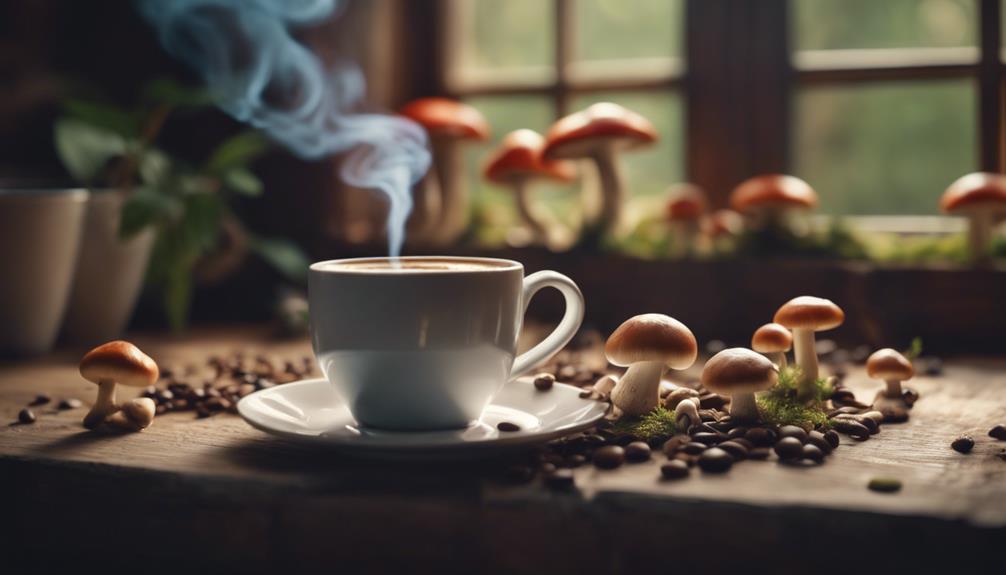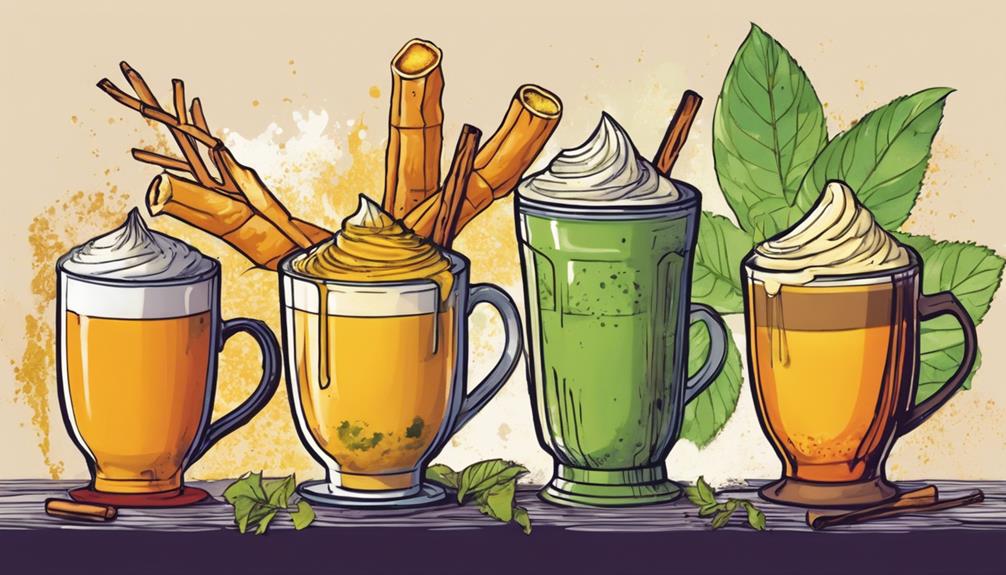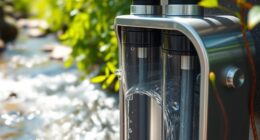Achieve mastery in the art of avoiding burnt coffee by adjusting grind size, utilizing high-grade beans, and ensuring proper tamping. Maintain optimal water temperature and avoid overfilling the basket. Invest in quality equipment and experiment with different roast levels to achieve the ideal brew. Tony Barlow shares expert tips on how to prevent a burnt taste. Explore factors such as milk quality and grinder settings to elevate your coffee experience. Dive into insights on the Indonesian coffee industry for a deeper understanding of sustainable practices. Elevate your coffee skills for a more flavorful and enjoyable brewing experience. Take your coffee journey to the next level by incorporating unique elements into your brewing space, like an engine block coffee table. Immerse yourself in the rich history and culture of coffee as you enhance your skills and knowledge. With the right techniques and tools, you can savor every sip of your perfectly brewed coffee while enjoying the aesthetic and functional appeal of an engine block coffee table.
Key Takeaways
- Opt for medium roast beans.
- Use water around 195-205°F for brewing.
- Avoid over-roasting beans.
- Ensure proper grind size and tamping.
- Invest in high-quality beans and equipment.
Common Causes of Burnt Coffee Taste
Over-roasting coffee beans can result in a burnt taste in your coffee. When water temperature is too high during the brewing process, it can also contribute to that unpleasant burnt flavor.
Dark roast coffee beans, due to their extended roasting process, are more likely to impart a burnt taste compared to medium roasts. Using high-quality beans is vital to avoid this bitterness, as well as ensuring proper grind size and tamping pressure.
The roasting process plays a significant role in determining whether your coffee will have a burnt coffee taste or not. To combat this, it's essential to focus on the quality of your beans, the brewing temperature, and the level of roasting.
Effective Strategies to Combat Burnt Coffee

To prevent the unpleasant burned taste in your coffee, implement effective strategies that combat this issue. One strategy to prevent the burned taste in your coffee is to use proper brewing techniques, such as monitoring the water temperature and using a burr grinder to ensure even coffee grounds. Additionally, be sure to store your coffee beans in a cool, dry place to maintain their freshness and flavor. Another way to combat the burnt taste in your coffee is to invest in a high-quality grinder and coffee maker, such as the engine block coffee table, to ensure that your coffee is brewed at the optimal temperature and extraction time.
Start by adjusting the grind size of your coffee beans to avoid fine grinds, which can lead to a bitter taste due to over-extraction during brewing.
Using high-grade beans and avoiding overfilling the espresso basket will also help maintain the best flavor profile, preventing the roast from becoming too intense and burned.
Proper tamping pressure is essential to guarantee an even extraction and prevent a burned taste in your coffee.
Additionally, pay attention to the water quality and temperature when brewing your coffee as they can greatly impact the taste.
Checking the milk quality used in your coffee is essential as well since low-quality milk can contribute to a burned flavor.
Remember, bitterness in coffee may signal over-extraction, leading to that undesirable burned taste.
Optimal Coffee Beans and Equipment
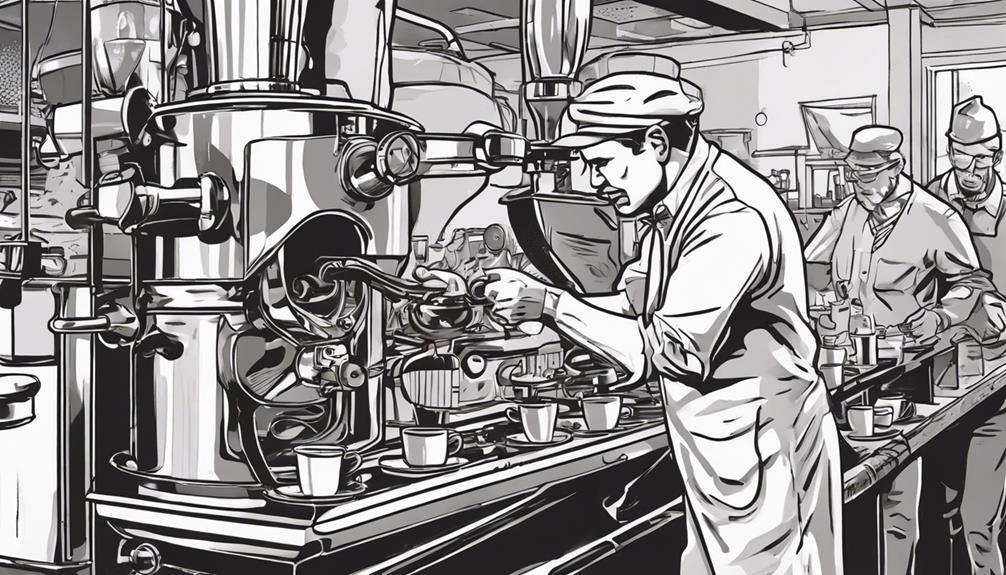
Selecting high-quality coffee beans and the right brewing equipment is essential for achieving the best flavor in your coffee. When it comes to coffee beans, freshness is key. Make sure to check the roast date on the packaging and opt for specialty coffee for a more refined taste profile. Additionally, pay attention to grind sizes suitable for your brewing device to ensure optimal extraction.
Consider investing in quality coffee equipment like the Nuova Simonelli Oscar II Espresso Machine to take your coffee brewing to the next level. Experimenting with different roast levels can also help you discover the perfect balance and richness in your cup of coffee.
| Optimal Coffee Beans and Equipment | |
|---|---|
| Freshness | Check the roast date and opt for specialty coffee. |
| Grind Sizes | Pay attention to grind sizes suitable for your brewing device. |
| Quality Equipment | Invest in high-quality coffee equipment like an espresso machine. |
| Roast Levels | Experiment with different roast levels for a balanced taste. |
Expert Tips From Tony Barlow
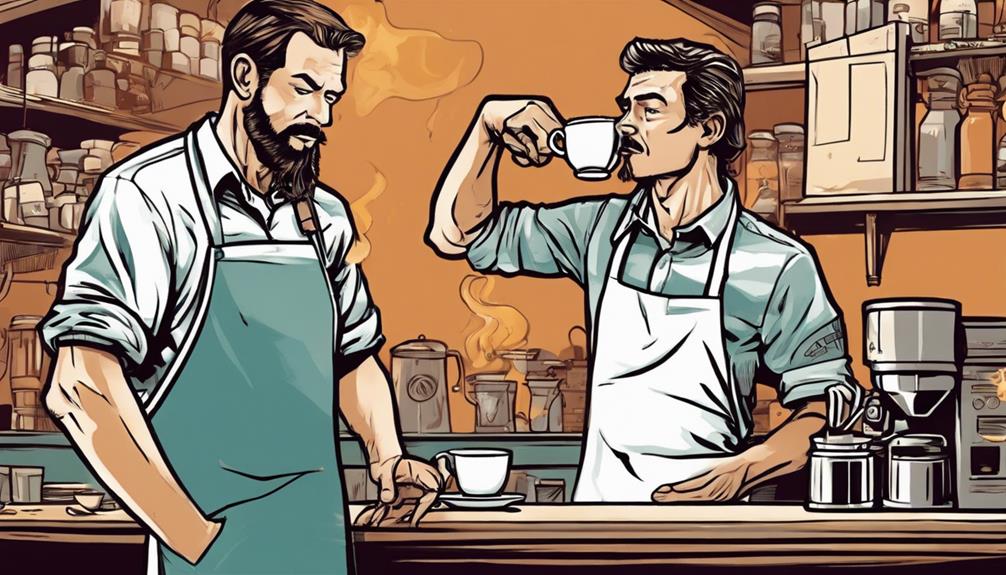
Tony Barlow's expertise in the coffee industry offers valuable insights on how to prevent burning your coffee. With a wealth of experience, Tony helps businesses select the right espresso machines and equipment to avoid the dreaded burnt taste in coffee. His passion for assisting customers in enhancing their coffee experience shines through in his expert tips on brew methods and equipment selection.
When it comes to preventing burnt coffee, Tony emphasizes the importance of using quality equipment like the Nuova Simonelli Oscar II Espresso Machine and Mahlkonig X54 Grinder, which Majesty Coffee proudly features.
Indicators and Solutions for Burnt Coffee
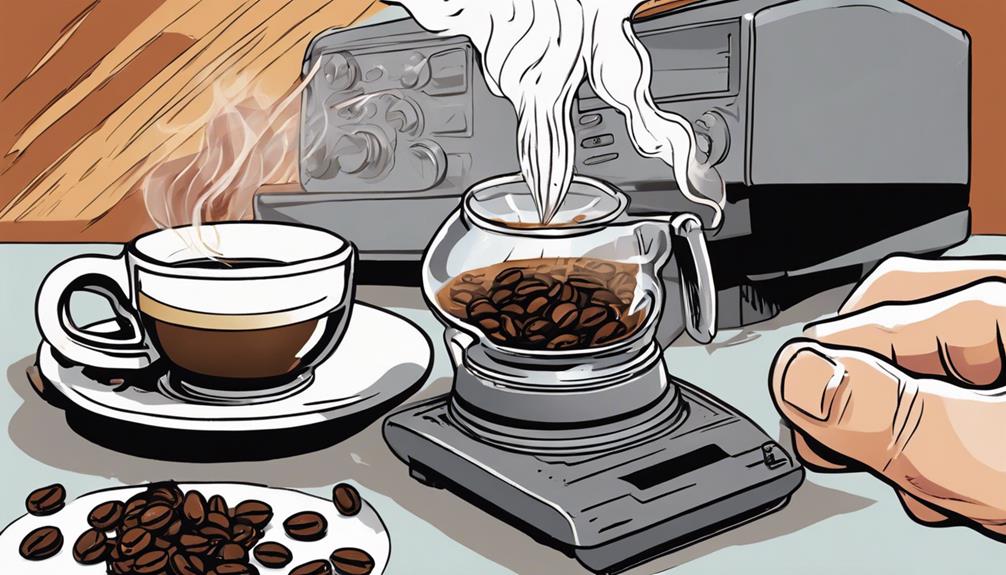
When looking for signs of burnt coffee, pay attention to indicators such as slow dripping, dark color, a soggy puck, and a lack of proper pour during extraction.
To prevent burnt tasting coffee, consider the following:
- Check Milk Quality: Confirm the milk used is fresh and of high quality to avoid imparting a burnt taste to your espresso drinks.
- Use High-Quality Beans: Opt for premium beans to maintain the integrity of the coffee flavor and prevent scorching.
- Proper Tamping: Ensure even and accurate tamping pressure to prevent over-extraction and charred flavors.
- Adjust Grinder Settings: Fine-tune your grinder settings to prevent over-extraction that can lead to burnt coffee.
- Avoid Over-Filling the Basket: Overfilling the basket can result in over-extraction, causing bitterness in coffee; be mindful of the quantity used.
Exploring Indonesian Coffee Industry
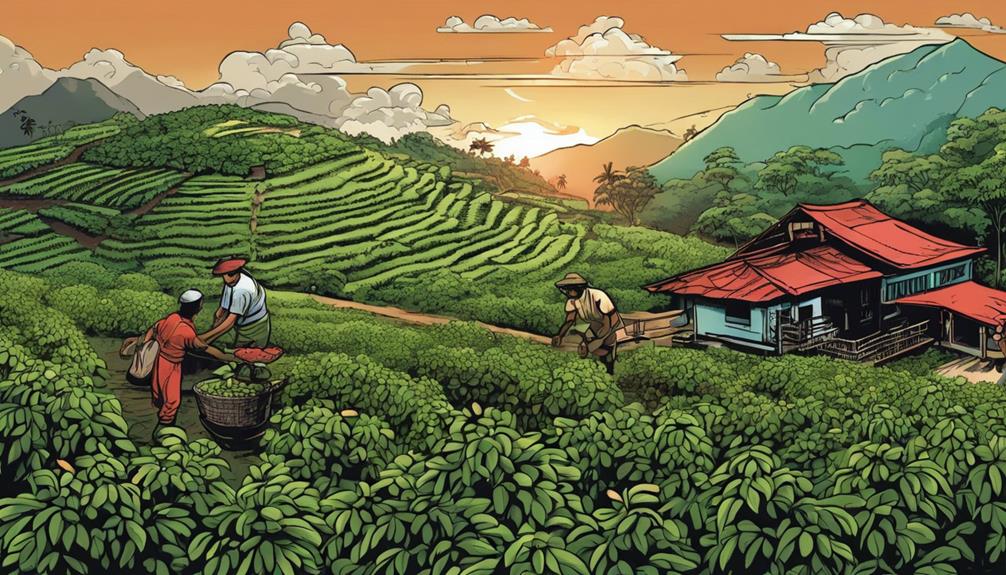
You'll learn about the diverse coffee regions in Indonesia, such as Java, Sumatra, and Sulawesi, each contributing to the country's vibrant coffee industry.
Discover the unique characteristics of Indonesian coffee, celebrated for its full-bodied flavor profile and low acidity that sets it apart in the world of coffee.
Explore the sustainability challenges faced by Indonesian coffee producers, from aging trees to the impact of climate change, shaping the industry's future.
Coffee Regions in Indonesia
Ranked as the 4th largest coffee producer globally, Indonesia boasts major coffee regions such as Java, Sumatra, and Sulawesi, each contributing unique flavors to the coffee industry.
When exploring Indonesian coffee regions, you'll find a diverse array of flavors and cultural significance linked to each area. Here are some key points to keep in mind:
- Java: Known for its earthy and spicy notes, Java coffee is ideal for those who enjoy a bold and robust cup of coffee.
- Sumatra: With its syrupy body and hints of chocolate and cedar, Sumatran coffee offers a rich and complex flavor profile.
- Sulawesi: Sulawesi coffee, characterized by its vibrant acidity and fruity undertones, provides a bright and lively drinking experience.
- Freshly Roasted Coffee Beans: Opt for freshly roasted Indonesian coffee beans to experience the full range of flavors each region has to offer.
- Brewing Tips: Use a Moka pot to brew your Indonesian coffee and avoid tasting burnt notes common with dark roast coffee.
Exploring these Indonesian coffee regions can be a delightful journey into the world of unique and flavorful coffee experiences.
Indonesian Coffee Characteristics
Indonesian coffee, renowned for its robust flavor profile and gentle acidity, stands out in the global coffee industry for its unique characteristics. The fertile volcanic soil and tropical climate of regions like Java, Sumatra, and Sulawesi contribute to the distinctive taste of Indonesian coffee.
However, obstacles such as aging trees and the impact of climate change on production have affected the industry. Efforts are underway to address these issues and enhance the quality and sustainability of Indonesian coffee.
By understanding the characteristics of Indonesian coffee, you can appreciate its diverse flavors and origins more deeply. The robust flavor and gentle acidity of Indonesian coffee make it a favorite among coffee connoisseurs worldwide.
As the 4th largest coffee producer globally, Indonesia continues to strive for excellence in coffee production while facing the challenges posed by aging trees and climate change.
Sustainability Challenges
In the Indonesian coffee industry, sustainability challenges pose significant hurdles for coffee producers working hard to maintain quality and environmental responsibility. With aging coffee trees and the impact of climate change affecting production, preserving the longevity of the industry necessitates a focus on sustainable practices.
- Burnt Taste: Over-roasting can lead to a burnt taste in coffee, impacting its quality and appeal.
- Compounds in the Coffee: Understanding the compounds present in coffee can help in enhancing the taste and overall experience.
- Unpleasant Taste: Factors like improper storage or processing can result in an unpleasant taste in the final brew.
- Impact of Climate Change: Climate change poses a threat to coffee production, impacting the quality and quantity of beans harvested.
- Sustainable Practices: Embracing sustainable practices, such as shade-grown coffee or organic farming, can help mitigate environmental impact and ensure long-term viability.
Frequently Asked Questions
How to Prevent Coffee From Burning?
To prevent coffee from burning, use a medium roast, monitor water temp at 195-205°F, adjust grind size, follow recommended brewing times, and clean equipment regularly. By doing so, you'll enjoy a delicious cup without that burnt taste.
Why Is My Coffee Maker Burning the Coffee?
Is your coffee maker burning your coffee? It could be due to overheating or prolonged brewing. Check for issues like incorrect temperatures, over-extraction, or using stale grounds. Regular maintenance can prevent burnt flavors, ensuring a perfect brew every time.
How to Make Coffee Without Burning It?
To make coffee without burning it, use a medium roast coffee, watch water temp (195-205°F), adjust grinder for correct grind size, don't overfill the basket, tamp properly, and try different brewing methods like pour-over or French press.
Does Bialetti Burn Coffee?
Bialetti can turn your coffee into a burnt disaster if you're not careful. Keep an eye on those water temperatures and experiment with grind sizes. Fresh beans are your best friend here.
Conclusion
So next time you're brewing your morning cup of joe, remember to keep a close eye on your brewing process to avoid that dreaded burnt coffee taste.
With the right beans, equipment, and techniques, you can enjoy a perfectly brewed cup every time.
Don't let your coffee go up in smoke – take these tips to heart and savor every sip of your favorite brew.
Cheers to a delicious cup of coffee without the burnt flavor!

